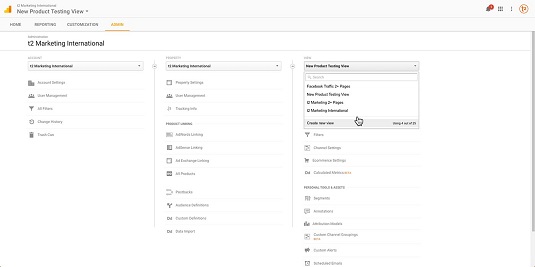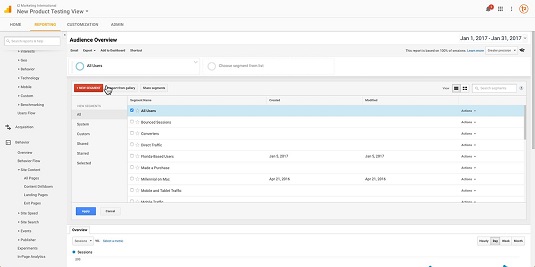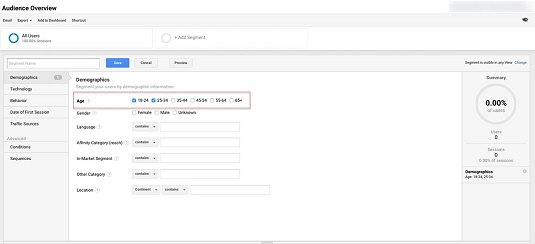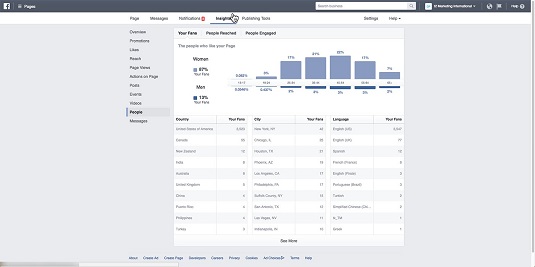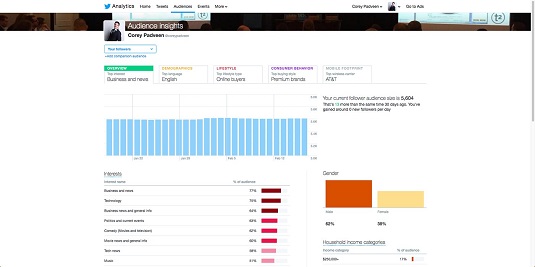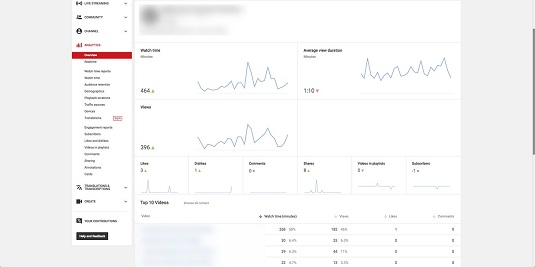- Data from your owned media channels like your website
- Data from social media channels like Facebook, Twitter, and YouTube
- Data from public channels
Data from your owned media
Perhaps the richest center of owned data is available from the backend on your website. Because the vast majority of businesses track their web data using Google Analytics.Within Google Analytics, you can segment data according to a variety of elements. One is the ability to segment by age.
Creating a segmented dashboard is simple and is useful when you want to isolate a specific cluster of data for deeper analysis. Simply follow these steps:
- Create a new view in order to avoid filtering other data.
A mistake that marketers often make is applying segments or filters to general Google Analytics data. Google doesn’t save data that it doesn’t collect, so when you filter out data from your general dashboard, it’s gone forever. Instead, create a new view in your admin dashboard and title it something specific, such as Millennial Web Data.
- Add a segment in your audience dashboard.
Select the option to add a new segment in your audience dashboard.
- Select a new segment and filter by age.
You can also filter by other criteria, but for the purposes of Millennials, you need to add only an age filter.
After you do this step, the data pulled into this segmented view will be only the data that fits the applied filters. Now, all the data you analyze in the backend of your website will relate specifically to the actions taken by Millennials visiting your website.
Another area of focus in the backend of Google Analytics will be your acquisition dashboard. Here, you’ll be able to identify the channels and campaigns that have driven the most Millennial engagement. This information allows you to optimize ad dollar spending and marketing budget allocation for the different networks.
Data from social media
When it comes to publicly available, accessible data on Millennial consumers’ habits and interests, you can’t find many places with such a comprehensive amount of information as social media. Millennials share everything, and you can access that data on several media platforms in order to leverage it:- YouTube
While you may not be able to segment your audience specifically by age on Facebook, like you can on your website, your audience will largely fall into the category of users that fit the Millennial mindset. This means that the observed habits that you identify in the backend and the content you analyze will be largely applicable to your Facebook content strategy.
Within Facebook, you can also export page and post-level data for further, more in-depth analysis. This data is exported pseudo-raw, which means that it’s segmented but not manipulated. You can manipulate this information using a variety of tactics or tools in order to discover new opportunities.
YouTube
Much like Google Analytics age and user data, YouTube links your content with profiles of the users watching your videos. This powerful approach provides you with a better understanding of your audience’s viewing habits so that you can develop even more successful video content. It also helps you create channel and content strategies that appeal to the Millennials watching your videos.Some of the details of YouTube view data include Watch time, Average view duration, and Views.
Data from public channels
You can find plenty of publicly available databases related to Millennials across the web. To manually sift through billions of public posts and bits of information would be impossible, so you’ll want to use tools that are designed to do that. Many of these products peruse tens if not hundreds of millions of online sources including blogs, forums, social networks, and ecommerce websites.These tools are designed to scour any readily available data on the web for keywords, phrases, and brand names in order to provide you with the most accurate view of what the conversation looks like. These data are then visualized in an easy-to-analyze format, which allows you to quickly and efficiently identify opportunities so that you can statistically justify your strategies.
The following list of tools have some of the highest user satisfaction reviews on the market. Each has the ability to filter your user data by age range, which will allow for the analysis of all publicly available information about Millennials across your industry.
- AgoraPulse: AgoraPulse offers a fairly broad range of services within its platform, from insights to management to engagement. Reporting with AgoraPulse is top quality, and it’s very affordable. (As of this writing, prices start at $49 per month.)
- Brandwatch: Brandwatch falls on the more costly side of the spectrum of data analysis tools, but the detailed data reports make it worthwhile. You can quickly analyze your brand from all angles and measure your performance across the web compared to your competitors. You can also drill down pretty deep into the data, which can be particularly useful when it comes to identifying new campaign opportunities.
- Mention: Mention is a simple yet powerful listening tool that offers some great insights into the conversations taking place within your industry and around your brand. You can analyze trends at the keyword level and use that data to exploit new opportunities.
A high user satisfaction rate for a tool or technology is a good starting point, but the key is to find the tool that’s right for you. Do your research and make sure that the investment in technology pays off for your company.


